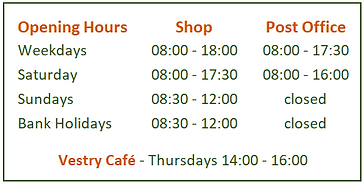

Operated by East Boldre Community Stores Limited, a voluntary organisation.
Owned by it members, predominantly local people.
Community Benefit Society, number 8481

The Graveyard
There are over 500 graves on the chapel's site. As all but one are now un-marked, it is not obvious that the land around the chapel is in fact a graveyard. 174 of the graves are children (36%), a testament to the high infant mortality of the time.
Onsite interpretation panels will be produced thanks to funding from the National Lottery Heritage Fund.



The Baptistry
Baptists only baptise adults or at least at an age where a person can make a conscious profession of their faith. Traditionally, it is done by full immersion and the chapel has a large baptistry to meet that need.
A detail in the layout of the parquet florring identifies its position. See if you can find it next time you are in store!

Uncle Eddie - East Boldre's Own 'Banksy'?
Many of the people who took part in our Living Memory interviews fondly mentioned 'Uncle Eddie', the chapel's Sunday School superintendent from 1946 until his death in 1984. Born Idris Williams on 29th December 1909, he was a Welsh miner before marrying Edith Read in Brockenhurst in1938. He later became a deacon at the chapel. He is shown below with his dog, Auggie, Edith and her sister May.
On 15th May 2023, as we removed the panelling in the chapel to address the damp behind it, we discovered Uncle Eddie's previously unknown graffiti artwork of his dog Auggie sporting sunglasses behind the pine panelling that we removed in order to address the damp. It gives a feel for Idris's sense of fun and why he is remembered fondly by so many people from when they were children.
Unfortunately, on exposure to air after years concealed behind the panelling within 24 hours Idris' artwork dried out and peeled off. We were so disappointed to find it as curls of paint on the floor the next morning. Luckily we had taken some photos before Uncle Eddie's artwork self-destructed.



Keeping warm
Near the fruit and veg you will see a darker patch in the parquet flooring. This indicates the position of the hearth for the cast iron stove that was used to heat the chapel (shown below).
Our building works included the removal of the stove's asbestos flue pipe that remained in the loft space above this area.
Today our shop is largely unheated as it keeps food fresher and customers typically are dressed for the weather. What heating we have is provided by efficient air source heat pumps powered by our solar system.

The Bricked up Windows
Window tax was introduced by William III to offset the revenue lost due to the clipping of coinage. A motion to repeal of the tax failed by three votes in April 1850. The tax was finally repealed in 1851.
It seems our chapel still had all of its windows in the painting circa 1860 below but they had been bricked up by 1908 (right). Therefore, it is unlikely that window tax was the reason; more likely it was to facilitate the addition of the mezzanine and its staircase or to reduce costs when the window frames needed replacing.

Ceiling Roses
As you enter Chapel Stores you will see the original cast iron ceiling roses now mounted on either side of the internal double doors. These were removed to make way for the new light fittings. As an original part of the chapel and one of its few decorative features, we reinstated the roses where their detail can be appreciated by everyone.
They were caked in centuries of paint which Nick carefully removed. Then Rebecca made a rubber mould from one of the originals and cast the 8 lightweight resin plaster roses that now decorate the ceiling.

Thanks to Liz Searle and Roy Kitcher we have a high resolution image of this watercolour that shows the chapel before two of the windows on the front facade were bricked up.

